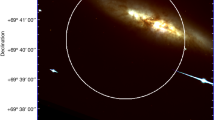Abstract
INFRARED observations of supernova 1987A are important for studying both the evolution of the ejecta and its interaction with the surrounding interstellar medium. Here we report observtions of SN1987A, in the spectral range 18–35μm, taken on 16 and 23 November 1988, 632 and 639 days after core collapse. A strong (∼10Jy at 20μm) and rather flat continuum underlies weak fine-structure lines from heavy elements, and declines slowly between 24 and 30μm. Its spectral shape is indicative of thermal emission from an almost featureless dust component, probably graphite, with silicates contributing <20% of the emitting dust mass. Some of the emission may be an 'echo' of supernova light reflected from a pre-existing dust cloud1, but a better explanation, which can account for the entirety of emission from infrared to gamma wavelengths, is that dust is being formed in the supernova ejecta2. This also accounts more naturally for the inferred dust composition. Continuous observation is needed to determine the relative importance of these two components of the infrared emission.
This is a preview of subscription content, access via your institution
Access options
Subscribe to this journal
Receive 51 print issues and online access
$199.00 per year
only $3.90 per issue
Buy this article
- Purchase on Springer Link
- Instant access to full article PDF
Prices may be subject to local taxes which are calculated during checkout
Similar content being viewed by others
References
Roche, P. F., Aitken, D. K., Smith, C. H. & James, S. D. Nature 337, 533–535 (1989).
Danziger, I. J., Gouiffes, C., Bouchet, P. & Lucy, L. B. IAU Circ. 4746 (1989).
Felten, J. E. & Dwek, E. Nature 339, 123 (1989).
Catchpole, R. M. & Whitelock, P. A. IAU Circ. 4751 (1989).
Heathcote, S., Suntzeff, N. & Walker, A. IAU Circ. 4753 (1989).
Crotts, A., Kunkel, W. E. & McCarthy, P. J. IAU Circ. 4791 (1989).
Draine, B. T. Princeton Observatory Preprint 213 (1987).
Chevalier, R. A. Nature 332, 514–516 (1988).
Fransson, C. et al. Astrophys. J. 336, 429–441 (1989).
Dwek, E. Astrophys. J. 297, 719–723 (1985).
Emmering, R. T. & Chevalier, R. A. Astrophys. J. 338, 388–402 (1989).
Barthelmy, S. et al. IAU Circ. 4593 (1989).
Pinto, P. A. & Woosley, S. E. Nature 333, 534–537 (1988).
Petuchowski, S. J., Dwek, E., Allen, J. E. Jr. & Nuth, J. A. III Astrophys. J. (in the press).
Clayton, D. D. Astrophys. J. (in the press).
Lewis, R. S., Tang, M., Wacker, J. F., Anders, E. & Steele, E. Nature 326, 160–162 (1987).
Dwek, E. Astrophys. J. 329, 814–819 (1988).
Author information
Authors and Affiliations
Rights and permissions
About this article
Cite this article
Moseley, S., Dwek, E., Glaccum, W. et al. Far-infrared observations of thermal dust emission from supernova 1987A. Nature 340, 697–699 (1989). https://doi.org/10.1038/340697a0
Received:
Accepted:
Issue Date:
DOI: https://doi.org/10.1038/340697a0
This article is cited by
-
Dust in Supernovae and Supernova Remnants II: Processing and Survival
Space Science Reviews (2018)
-
A supernova origin for dust in a high-redshift quasar
Nature (2004)
Comments
By submitting a comment you agree to abide by our Terms and Community Guidelines. If you find something abusive or that does not comply with our terms or guidelines please flag it as inappropriate.



